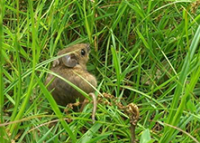Home > News > Non-lethal experiment on «small mammals and contaminants»

Non-lethal experiment on «small mammals and contaminants»
11 juillet 2014
In the continuity of researches about the effects of urbanization on populations of great and blue tits, the co-exposure pollutants/pathogens in bats and wild rodents, and the development of non-lethal approaches for ecotoxicological studies on small mammals, research works on small mammals communities and at population and individual level on the wood mouse Apodemus sylvaticus were conducted this springtime in the LTER ZAAJ.

Does urbanization affect the health status of small mammals?
What are the effects of urbanization on small mammal communities and wood mouse population dynamics? Are urban wood mice more exposed to metal pollutants and polycyclic aromatic hydrocarbons than forest wood mice? Are they less healthy? Are they more exposed to pathogens? What may be the implications of urbanization on disease transmission to human populations?
The general context of these researches deals with the effects of urbanization on ecosystem health. This springtime, our study aimed at assessing, in several sites located in Besançon and Forêt de Chaux, (i) small mammal communities (species present and estimated densities), and (ii) the health status (haematology, body condition index, immunocompetence), the exposure to chemical contaminants (trace metals and polycyclic aromatic hydrocarbons) and to biological contaminants (for instance Borrelia ssp and Anaplasma ssp, which are pathogens responsible for zoonosis) and the relationships between these different parameters in the wood mouse Apodemus sylvaticus.
The first fully non-lethal experiment !
The works conducted during the last decades on small mammals were based on lethal experiments, which allowed sampling of organs to measure chemical and biological contaminants and to realize various analyzes (histopathology, biomarkers of exposure to/effects of pollutants, markers of immunocompetence, …), and to determine precisely age, sex and sexual activity, as well as studying the diet using stomach contents.
For ethical and scientific reasons, our team wished to develop non-lethal experiments, this partly on the basis of the methods used by Renaud Scheifler, Michaël Coeurdassier and Clémentine Fritsch for studies on birds. These developments started within the context of Nicolas Tête’s PhD, and continued during the research program of Nico van den Brink (senior scientist at the research institute Alterra in Wageningen, The Netherlands; invited by Chrono-environnement thanks to a funding from the Conseil Régional de Franche-Comté). They reach their fulfilment this very year, with a first fully non-lethal experiment!
The team gathered Clémentine Fritsch, Dominique Rieffel, Renaud Scheifler and Elodie Swaempoel (1st year Master student at the Université de Montpellier).
On the programme:
- trapping in the field (INRA trap with dormitory filled with hay, apple, cat food and peanut butter) in the city of Besançon (Campus Bouloie and Botanic garden Place Leclerc) and in two sites in Forêt de Chaux,
- capture of small mammals, where shrews, voles and garden dormouse are released, wood mice only are sampled,
- and experiments on wood mice.
The experiments on wood mice begin with handling and anesthesia, followed then by morphometric measurements (body weight and size), blood sampling, individual marking, sampling of a piece of ear, determination of sex and sexual activity, count of external parasites. The wood mice are then placed in “all comforts” chambers filled with hay, apple and sunflower seeds, where they wake up within the coming hour and can recover until their release on the next morning.
The (long!) days last with haematological analyzes on fresh blood, smear coloration (for cell count and search for blood parasites) and blood preparation (sub-sampling and separation plasma/red blood cells) and storage for the further analyzes (measurements of metals and hydrocarbons, immunological profiles, analysis of pathogens using molecular biology techniques).
The analyzes of metals and polycyclic aromatic hydrocarbons are realized at the department Chrono-environnement by Nadia Crini et Caroline Amiot. The pathogens as well will be analyzed in our lab by Eve Afonso. Finally, immunological profiles will be done in collaboration with Bruno Faivre from the department Biogéosciences at the Université de Bourgogne.
A real success for this first non-lethal experiment
- sufficient capture success (78 animals captured, including 41 wood mice), extremely low mortality for non-target species and wood mice sampled (less than 3%),
- sufficient blood volumes sampled for the analyzes planed but in accordance with the recommendations concerning non-hazardous volumes collected,
- no apparent sequelae due to anesthesia and blood sampling since individuals behave normally in recovery chambers (visit of the environment, grooming, feeding, rest and sleep), and get back to the field running and jumping!
Contact: Clémentine Fritsch












